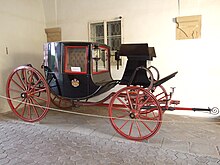

The chariot that evolved from the ancient vehicle of this name (see Chariot) took on two main forms:
- A light, four-wheeled, horse-drawn carriage having a curved coach box with back seats only (a type of coupé), popular in the early 19th century.
- A vehicle for conveying persons especially in state, such as a triumphal car or a coach of state. This stately but manoeuvrable horse carriage was used for ceremonial occasions or for pleasure.
A chariotee was a light, covered, four-wheeled pleasure carriage with two seats.
A post chariot was a carriage for traveling post. The term was used specifically for a kind of light four-wheeled carriage with a driver's seat in front.
A vehicle such as a cart or wagon for transporting goods was also sometimes called a chariot.
See also
References
- Chariotee Clipart. Clipart ETC.
- The Casanova Tour - by Pablo Günther - The English Coupé or Post Chariot - Casanova Magazine. Archived February 4, 2008, at the Wayback Machine Giacomo Casanova - Reisewagen im 18. Jahrhundert (Travelling Carriages in the 18th century).
- 98/43/1 Coach, horsedrawn, travelling chariot, coupe, timber/metal, used by Alexander Berry in Sydney, made by Thrupp, London, England, c.1850 - Powerhouse Museum Collection. Powerhouse Museum | Science + Design | Sydney Australia.
This vehicle-related article is a stub. You can help Misplaced Pages by expanding it. |